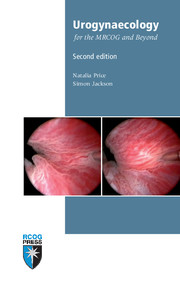Book contents
- Frontmatter
- Contents
- Preface
- Abbreviations
- 1 Applied anatomy and physiology of the lower urinary tract
- 2 Definition and prevalence of urinary incontinence
- 3 Initial assessment of lower urinary tract symptoms
- 4 Further investigation of lower urinary tract symptoms
- 5 Management of stress urinary incontinence
- 6 Management of overactive bladder syndrome
- 7 Recurrent urinary tract infection
- 8 Haematuria
- 9 Painful bladder syndrome and interstitial cystitis
- 10 Pregnancy and the renal tract
- 11 Ageing and urogenital symptoms
- 12 Fistulae and urinary tract injuries
- 13 Pelvic organ prolapse
- 14 Colorectal disorders
- 15 Obstetric anal sphincter injuries
- Index
8 - Haematuria
Published online by Cambridge University Press: 05 July 2014
- Frontmatter
- Contents
- Preface
- Abbreviations
- 1 Applied anatomy and physiology of the lower urinary tract
- 2 Definition and prevalence of urinary incontinence
- 3 Initial assessment of lower urinary tract symptoms
- 4 Further investigation of lower urinary tract symptoms
- 5 Management of stress urinary incontinence
- 6 Management of overactive bladder syndrome
- 7 Recurrent urinary tract infection
- 8 Haematuria
- 9 Painful bladder syndrome and interstitial cystitis
- 10 Pregnancy and the renal tract
- 11 Ageing and urogenital symptoms
- 12 Fistulae and urinary tract injuries
- 13 Pelvic organ prolapse
- 14 Colorectal disorders
- 15 Obstetric anal sphincter injuries
- Index
Summary
Haematuria may originate from any site along the urinary tract and may signify underlying pathology. It may be microscopic or macroscopic but investigations are similar.
Prevalence
Using dipstick testing the prevalence of haematuria in the general population is 2–16%. Dipstick testing is sensitive but not specific and it may detect physiological amounts of blood in the urine. Therefore, while it is a useful screening test, the finding should be confirmed with microscopy. Microscopic haematuria is present if there are three or more red blood cells per high power field in urinary sediment from two of three freshly voided clean-catch midstream urine specimens. The prevalence of haematuria on microscopy is between 1% and 5%.
Aetiology
In women under 50 years with microscopic haematuria 2–10% will have urinary tract pathology. This is most commonly stones, specific infections and nephritis. Urinary tract malignancy is rare in women under 40 years. Approximately 10–20% of women over 50 years with microscopic haematuria will have significant urinary tract pathology, which is often malignancy, and this risk is increased if frank haematuria is present.
Clinical history
Recent menstruation or sexual trauma may be another source of the bleeding and the clinician should try to differentiate haematuria from vaginal and rectal bleeding. Urinary frequency or dysuria suggest a urinary tract infection, which is the most common cause of haematuria in young women. Urinary tract calculi may be associated with pain, and glomerulonephritis or nephropathy may be secondary to a recent upper respiratory tract infection, rash or oedema.
- Type
- Chapter
- Information
- Urogynaecology for the MRCOG and Beyond , pp. 65 - 70Publisher: Cambridge University PressPrint publication year: 2012

